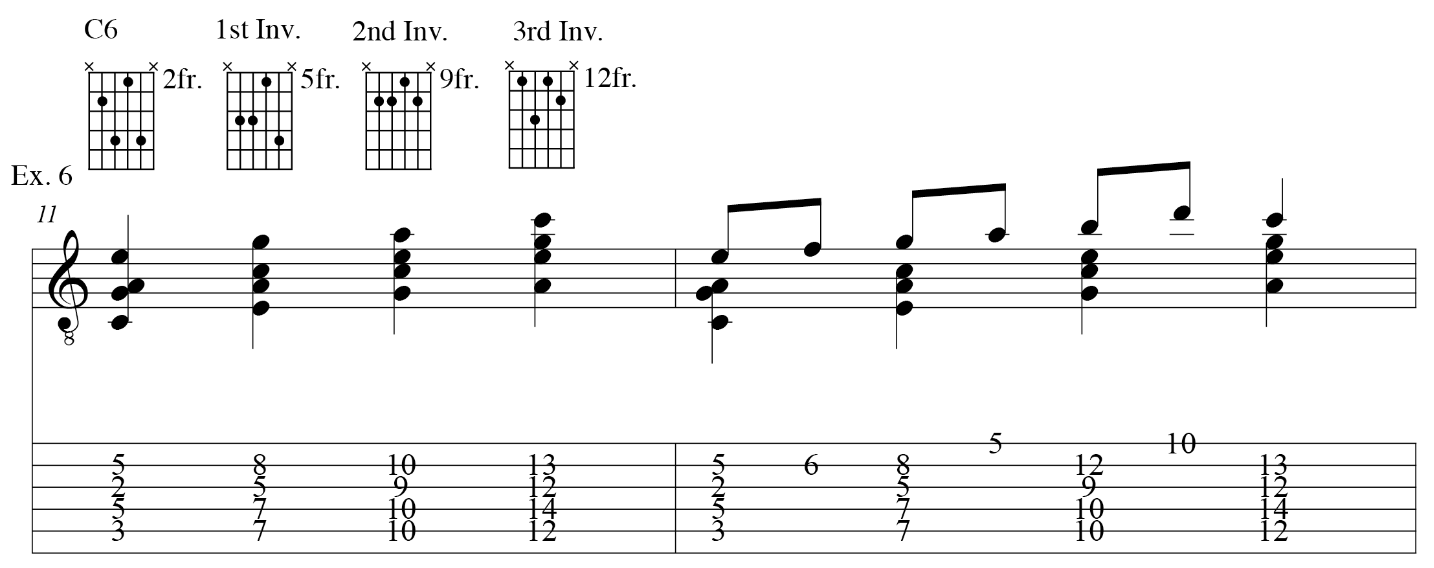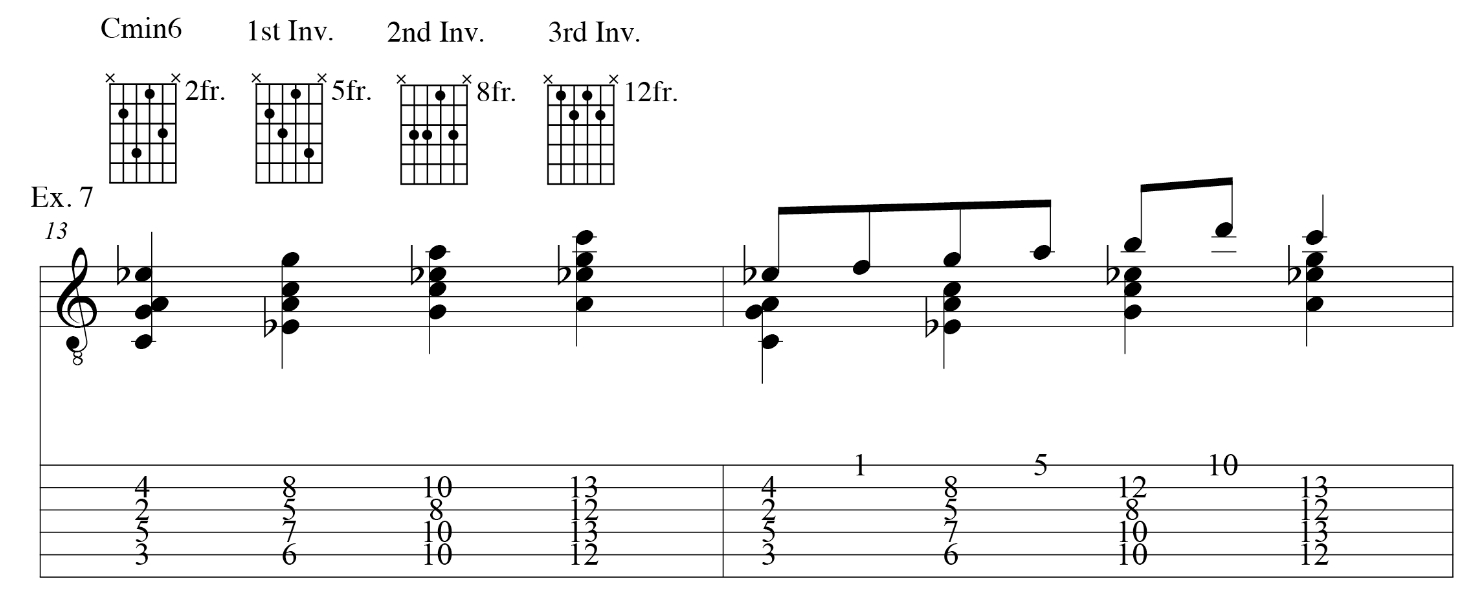Workshop - Eclectic Electric Systematic Inversions Part 2
This workshop was originally published in the Winter 2016 issue of the Fingerstyle Guitar Journal. To receive fingerstyle guitar interviews, workshops, reviews, and more automatically each quarter subscribe to the Fingerstyle Guitar Journal
Inversion Immersion
Welcome to Eclectic Electric. This time we’ll be continuing our discussion of Systematic Inversions.
The basic premise is that we’re going to use systematic inversions to create four voicings of each chord quality and then we’re going to use the upper diatonic neighbor of the top voice to create a scale that melodically connects the four inversions. The first root position chord in each example has the 3rd or b3rd as the top voice so we will make a melody that starts on the third and climbs up in 8th notes. The fingerings, some of which may seem difficult or odd, are suggested to keep as many notes ringing as possible to create a nice legato effect. After you get these examples under your fingers and in your ears try to experiment with various melodic rhythms to keep things interesting.
Example 1
Example 1 starts with C major7 on the middle set using a voicing that is spelled 1573. All of the subsequent chord qualities will start with this voicing on the middle set so when we play the melody portion we play a scale that starts on the 3rd and climbs up. Then to make it resolve nicely at the end I skip over the root and play the 9th and then come home to the root on top of a 3rd inversion voicing. Remember, the written examples are mere starting places, so for example, you also might try replacing the F with F# in this passage to create a Lydian sound. Another possibility if you’re very ambitious is to raise all the Gs in the inversions to G# creating Maj7#5 and then use F# in the melody as well and you will be then playing something which is drawn from the 3rd degree of A melodic minor.
Example 1
Example 2
Example 2 is C7 and it’s inversions with 4, 6, and 9 as upper neighbors. With Dominant 7 chords the possibility for extensions and alterations are quite varied. Here I just stick with a mixolydian sound. Of course if you want to you can add a b9 (Bb) or a #9 (D#) and you can also play around with the 5ths in the chord voicings. This will venture into the altered territory, more on this in subsequent articles.
Example 2
Example 3
Example 3 is C minor7 and it’s inversions on the middle set again. I used natural extensions here to create a Dorian sound with a 4, 9 and 6. If you want to play around with this, and I would recommend that you do, try a replacing the A note with Ab and the D with Db to create a Phrygian sound. Then use Ab with D to create the Aeolian sound. If you don’t understand the minor modes it 37 might be a good idea to find a good teacher or book to help you understand the difference between dorian, phrygian and aeolian
Example 3
Example 4
Example 4 is C minor7b5 and it’s inversions. In the melodic passage I’m using b6 and b9 to create the sound of the 7th degree of the major scale. This is known as the Locrian mode. You can also use the natural 9th, which will give you the 6th degree of melodic minor.
Example 4
Example 5
Example 5 is C minor/ maj.7 and it’s inversions. It’s a challenging sound but I think you might find it very interesting. You can think of this as being the tonic chord in melodic minor or harmonic minor. The extensions used in the melodic passage on this particular example come from harmonic minor. If you use natural 6 (A) along with natural 9 (D) you will create a melodic minor sound.
Example 5
Example 6
Example 6 is C6. If you look closely you might notice that C6 and it’s inversions look just like A minor7 and it’s inversions. You’ll notice that the 3rd inversion of C6 looks just like root position of A minot7, so that’s good news because that means everything we already know about A minor 7 we also know about C6 and visa versa. In this example I used natural extensions 4, 6, and 9. You might also experiment with #4.
Example 6
Example 7
Example 7 is C minor 6 and it’s inversions. You’ll notice that the fingering is a little clunky and there are some special techniques necessary to play them. For instance the F natural while the other notes continue to ring. For now just do your best. In this case were using C minor 6 with 4, 6 and 9 as melodic connectors and that is indicative of the melodic minor sound. You can think of C minor 6 as the tonic chord of melodic minor since it’s a bit easier to hear than minor/ major 7. You also might have noticed that C minor 6 chords look like minor 7b5 chords and you would be right! C minor 6 and A minor 7b5 contain the same four notes.
Example 7
Example 8
Example 8 is C diminished 7 and it’s inversions. Because diminished 7 chords are symmetrical all the inversions look the same and occur every three frets. The melodic extensions that we add are the 4, b6, 7 and 9 creating a diminished scale rising from the b3rd. Experiment with fingering this rising melody in a few different ways until you are comfortable.
Example 8
Next time we’ll look at what we can do with the top set of strings with a rising melody in the bass. Slowly but surely over the next few issues we will work our way toward developing a vocabulary of fluid inversions that can be used to make melodic chord passages.
I hope you enjoy the sounds and begin incorporating them into your every day playing.







